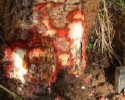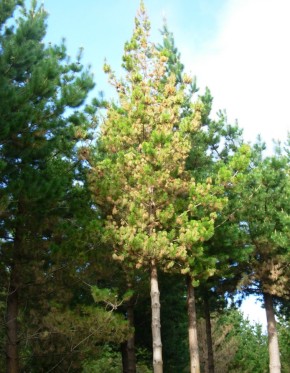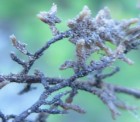PESTS AND DISEASES OF FORESTRY IN NEW ZEALAND
Small Forests & Woodlots
A guide to conducting forest health assessments and sampling:
ROOTS and ROOT COLLAR
 A resin or sap response at the root collar or an even yellowing or decline of the crown may indicate a pathogen problem at the root collar or roots.
A resin or sap response at the root collar or an even yellowing or decline of the crown may indicate a pathogen problem at the root collar or roots.

indicates a root disorder
The introduced bark beetle Hylastes ater also commonly attacks the roots and root collar of pine seedlings.
For seedlings (1-2 yrs old) pull out a small representative sample and check for signs of obvious damage or lack of root growth after planting. With conifers look for the presence of mychorrhiza. If there has been no noticeable root growth since planting, this is an indication the seedlings are not healthy or even were unthrifty when planted.
Often poor site conditions or the presence of pathogens are indicated by a lack of healthy mychorrhiza. These beneficial fungi are vital for the adequate nutrient uptake for many trees.

seedling (left)

In older stands take the opportunity to investigate any windthrow trees. Peel or chip away bark on the roots to look for rot pathogens like Armillaria which will usually appear as white leather sheaths under the bark. Blackened roots where the bark sloughs off is a good indication of a root rot such as phytopthora and will often be associated with wet site conditions.
The appearance of mushrooms, brackets and conks on the root collar or roots is serious as they usually indicate severe heart rot or root rot.
Sampling
Sample as you would for stems and branches.






